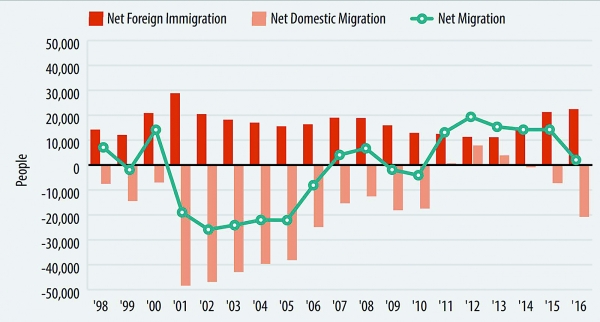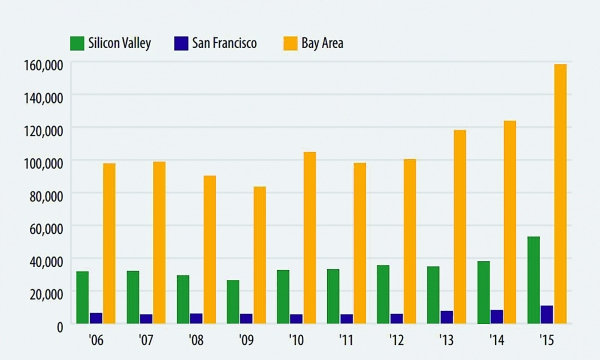As the economic engine of Silicon Valley continues to churn out jobs, mint millionaires and attract new employees, the region is increasingly buckling under the strain of the recent success, with longer traffic commutes, a soaring cost of living and a steep housing shortage frustrating business leaders and residents alike.
That's the overarching message of the 2017 Silicon Valley Index, a comprehensive look at the region (defined as San Mateo County, Santa Clara County, Scotts Valley, Fremont, Newark and Union City) that the nonprofit Joint Venture Silicon Valley released Feb. 16.
The report shows that the area's economy, despite a slight slowdown from 2015, continues to chug along and serve as a magnet for people from all over the world. It also indicates, however, that the region's economic inequality continues to grow and that its infrastructure is grossly inadequate.
In that sense, the report is a tale of two regions. On one hand, Silicon Valley continues to experience job growth and a declining unemployment rate (which hit a low of 3.1 percent last May and stood at 3.3 percent in November). Since emerging from the Great Recession in 2010, the Valley has added 297,000 jobs, including 45,621 in 2016. The number of tech jobs, which make up the largest share, increased by 5.2 percent last year.
While the sectors of biotech, internet and computer design enjoyed the most growth, they weren't the only ones experiencing a boom. According to the report, the region added 6,864 new construction jobs and 6,829 new health care jobs.
The Valley's average annual earning reached its highest level to date last year ($125,580) and per capita income was also at an all-time high ($86,976). All these figures, the Index notes, "dwarf those of the state and the nation."
Inequality
At the same time, inequality in the region is as bad as it's ever been, with some ethnic groups actually losing ground. While white, Asian and black residents saw slight improvements in per capita incomes, Hispanic or Latino residents and those identifying as "multiple and other" saw their earnings dip.
The Index also noted that one out of every 12 residents now lives below the federal poverty threshold and one in 11 children lives in poverty. And even as incomes continue to rise, median wages in service occupations have actually declined by 8 percent since 2010, when adjusted for inflation.
Put in more concrete terms, 29 percent of the households in Silicon Valley "do not earn enough money to meet their basic needs without public or private, informal assistance, and this share jumps up to 59 percent for those with Hispanic or Latino householders."
Indeed, the report documents widening disparities between ethnicities, genders and residents with different educational attainments. The gap between the region's highest- and lowest-earning racial and ethnic groups increased by 40 percent in the past decade (in 2015, it amounted to about $47,000).
Even for those who don't occupy the lowest economic strata, the dream of home ownership is growing increasingly out of reach. The Index notes that Silicon Valley's housing costs are "crippling huge swaths of our population," with those in the lowest-paying professions suffering the most.
Home prices
"The median sale price of homes in Silicon Valley reached $880,000 in 2016, a price fewer than 40 percent of first-time homebuyers can afford," the Index states. "Furthermore, only a small share of recent housing permits were affordable for low-income residents."
According to the Index, the percentage of new residences designated as "affordable" has dipped over the past year. In 2015, there were 1,758 such homes approved, making up 16 percent of the total number of new residential units. In 2016, the percentage dropped to 7 percent, with only 1,404 residences across the region designated as "affordable."
Income and education
The report also indicates a growing gap between residents with graduate or professional degrees and those without them. While the median income for those on the highest strata of educational attainment went up by $3,578 between 2014 and 2015, it actually went down over the same period for those with lower levels of education. As a result, those at the highest tier earned about $86,000 more (or 4.8 times as much) as those at the bottom. This disparity is somewhat higher in Silicon Valley than in San Francisco (where the ratio is 4.5) and significantly higher than across the nation (3.2).
Gender gap
The gender-income gap also remains a persistent source of shame for the politically liberal region. Men in Silicon Valley with bachelor's degrees earn 50 percent more than women with the same degrees. This means that a woman with a bachelor's earns 67 cents for every $1 earned by a similarly educated man. While the gap narrows slightly for those with graduate or professional degrees (in which case, a woman earns 71 cents for every dollar earned by a man), the Valley's ratio for all women working full-time (74 cents per dollar) is worse than either in San Francisco (77 cents) or California (79 cents).
Immigrants
The report also underscores the outsized role that immigrants play in the region's economy, a particularly topical finding at a time when the White House is pursuing more restrictive immigration policies (by a coincidence, the report was released on the same day as the national "Day Without Immigrants" strike). Forty-six percent of the region's employed residents are foreign-born, according to the Index. This includes 62.8 percent of the employers in "computer and mathematical" fields and 60.5 percent of those in "architectural and engineering."
"Historically, immigrants have contributed considerably to innovation and job creation in the region, state and nation," the Index states. "Maintaining and increasing these flows, combined with efforts to integrate immigrants into our communities, will likely improve the region's global competitiveness."
The numbers are particularly high when it comes to women who are between the ages of 25 and 44 years and who are employed in computer, mathematical, architectural and engineering occupations. About 76 percent of these women are foreign-born, according to the Index. Furthermore, the percentage of residents who speak a foreign language at home rose from 48 percent in 2005 to 51 percent in 2015 (in San Francisco it actually went down from 46 to 44 percent).
Population
Even with the high number of immigrants, the overall population of Silicon Valley remains relatively stable. In fact, one of the more striking findings in the new report is the growing number of people who left the Valley last year.
The "out-migration" in the Valley was greater in 2016 than in any other year since 2006, the report notes, with about 20,000 people departing for other parts of the state and country last year. This is a sharp break from just three years ago, when the region was showing more people coming in from other parts of the country than leaving.
And birth rates in Silicon Valley have declined by 13 percent since 2008 (in California at large the drop was even more significant at 14 percent), dropping to their lowest levels since the mid-1980s.
While population continues to grow, the rate slowed markedly last year. From 2010 to 2015, Silicon Valley had experienced population growth of about 34,000 per year. Between July 2015 and July 2016, it slowed to a gain of 19,000, according to the Index. With more people leaving the Valley than coming in, the growth was almost entirely due to natural growth (births minus deaths), according to the Index.
Traffic
The report also highlights one key problem that continues to unite people of all backgrounds: worsening traffic. According to the new report, since 2005 there has been an increase of 228,000 Santa Clara and San Mateo County residents who commute to work, along with 57,000 additional commuters who come into Silicon Valley from San Francisco and Alameda counties. As a result, commute times have risen by 17 percent.
According to the report, the worsening commute since 2015 has added 35 hours of driving time per commuter annually (or 40 minutes weekly). The growing congestion comes despite the slight drop in commuters who drive alone to work (which went from 75 percent in 2010 to 73 percent in 2015) and an small uptick in the number of people who relied on public transportation (which increased from 5 percent to 6 percent between 2010 and 2015).
Job growth
Joint Venture CEO and President Russell Hancock said in an introduction to the Index that the pace of growth in 2016 slowed down "ever so slightly," with the region losing a percentage point in the rate of job growth. Hancock noted that the market has made "necessary corrections to some overvaluations" and the region saw fewer IPOs this past year (nine in 2016, compared to 16 in 2015 and 23 in 2014).
Yet he he also pointed out that there is "no talk of a bubble bursting." If anything, he wrote, "the talk is about the toll our growth is taking on the region as we move into robotics and artificial intelligence."
Hancock also acknowledged that the region's growth "has its perils."
"It strains our infrastructure, decreases our quality of living and puts housing out of reach for too many," Hancock wrote. "Growth can also be troubling when it isn't widely shared. Unfortunately, our report shows that income disparities are more pronounced than ever, changing the character of our region and raising profound questions about community and cohesiveness."
While the report highlights the steep challenges facing the Silicon Valley (which is defined as San Mateo County, Santa Clara County, Scotts Valley, Fremont, Newark and Union City), Hancock pointed to the "growing recognition that these challenges ultimately erode our innovation ecosystem and threaten the very foundation of our prosperity." He alluded in his introduction to Measure A and Measure B, which Santa Clara County voters approved last fall to support new housing and transportation improvements, respectively.
"Our region's storied innovation has served us so extremely well in the commercial realm," Hancock wrote. "Now, with the stakes so high, we need to apply that same spirit of innovation to our social and civic challenges."
---





Comments